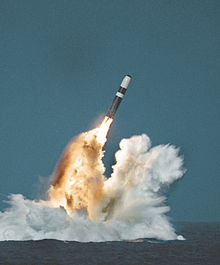| UGM-133A Trident II | |
|---|---|
 A Trident II launch from a submerged Royal Navy submarine.[citation needed] | |
| Type | SLBM |
| Place of origin | United States |
| Service history | |
| In service | 1990–present |
| Used by | United States Navy Royal Navy |
| Production history | |
| Manufacturer | Lockheed Martin Space |
| Unit cost | $30.9 million (2019)[1] |
| Produced | 1983 |
| Specifications | |
| Mass | 130,000 lb (59,000 kg)[2] |
| Length | 44 ft 6.6 in (13.579 m) |
| Diameter | 6 ft 11 in (2.11 m) (1st stage)[2] |
| Warhead | 1–12 Mk-5 RV/W88 (475 kt) or 1–14 Mk-4 RV/W76-0 (100 kt) or 1–14 Mk-4A RV/W-76-1 or(90 kt) or unknown Mk-7 RV/W93 (unknown kt)[3] Single or multiple W76-2 (5–7 kt)[4][5] |
| Engine | Three solid-fuel rocket motors; first & second stage – Thiokol/Hercules solid-fueled rocket; third stage – United Technologies Corp. solid-fueled rocket[6] |
| Propellant | NEPE-75:[7] Nitrate ester, plasticized polyethylene glycol-bound HMX, Aluminum, ammonium perchlorate |
Operational range | More than 7,500 mi (12,000 km)[8][9] (exact is classified)[10] |
| Maximum speed | Approximately 18,030 mph (29,020 km/h) (Mach 24; 8,060 m/s)[2] (terminal phase) |
Guidance system | MK 6 astro-inertial guidance which is able to receive Global Positioning System updates[2][11] |
Steering system | Single movable nozzle actuated by a gas generator |
| Accuracy | 100 m[12][13] |
Launch platform | Ballistic missile submarine |
The UGM-133A Trident II, or Trident D5 is a submarine-launched ballistic missile (SLBM), built by Lockheed Martin Space in Sunnyvale, California, and deployed with the United States and Royal Navy. It was first deployed in March 1990,[6] and remains in service. The Trident II Strategic Weapons System is an improved SLBM with greater accuracy, payload, and range than the earlier Trident C-4. It is a key element of the U.S. strategic nuclear triad and strengthens U.S. strategic deterrence. The Trident II is considered to be a durable sea-based system capable of engaging many targets. It has payload flexibility that can accommodate various treaty requirements, such as New START. The Trident II's increased payload allows nuclear deterrence to be accomplished with fewer submarines,[14] and its high accuracy—approaching that of land-based missiles—enables it to be used as a first strike weapon.K